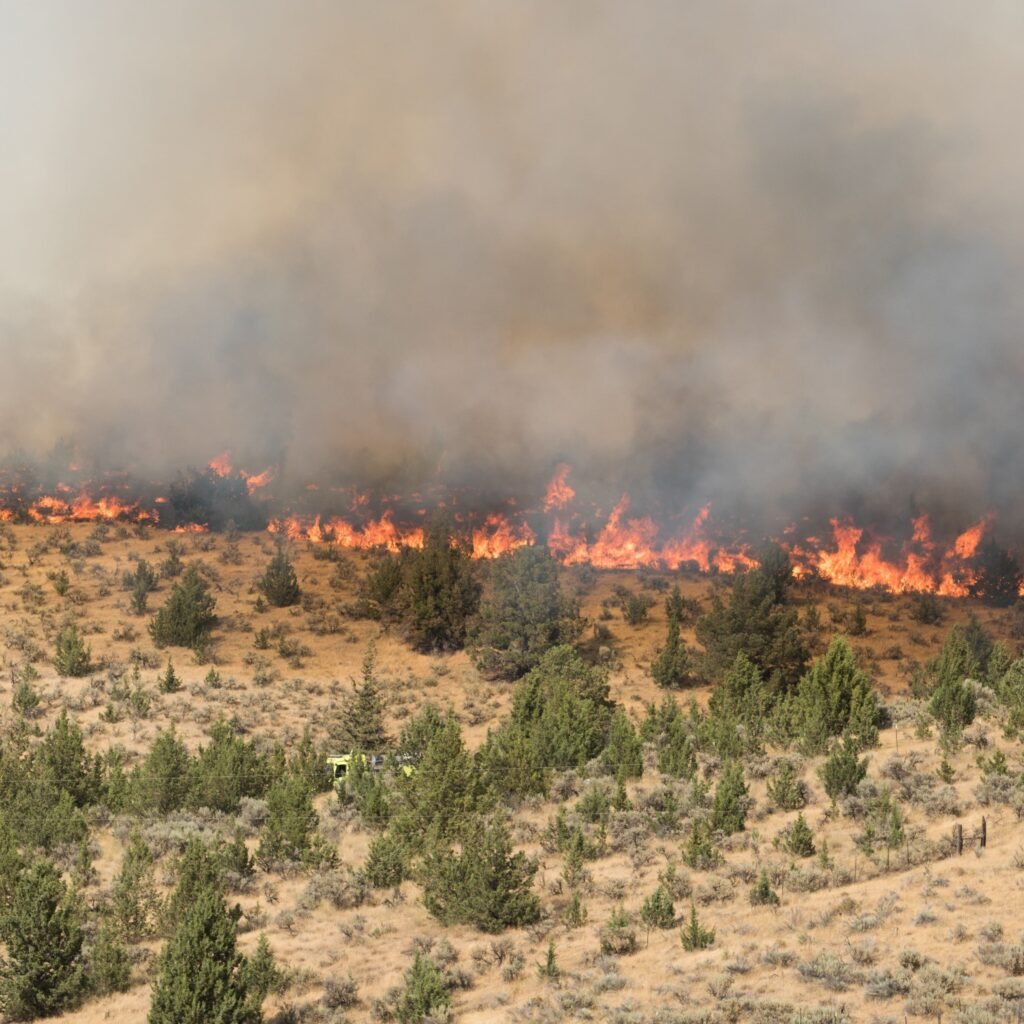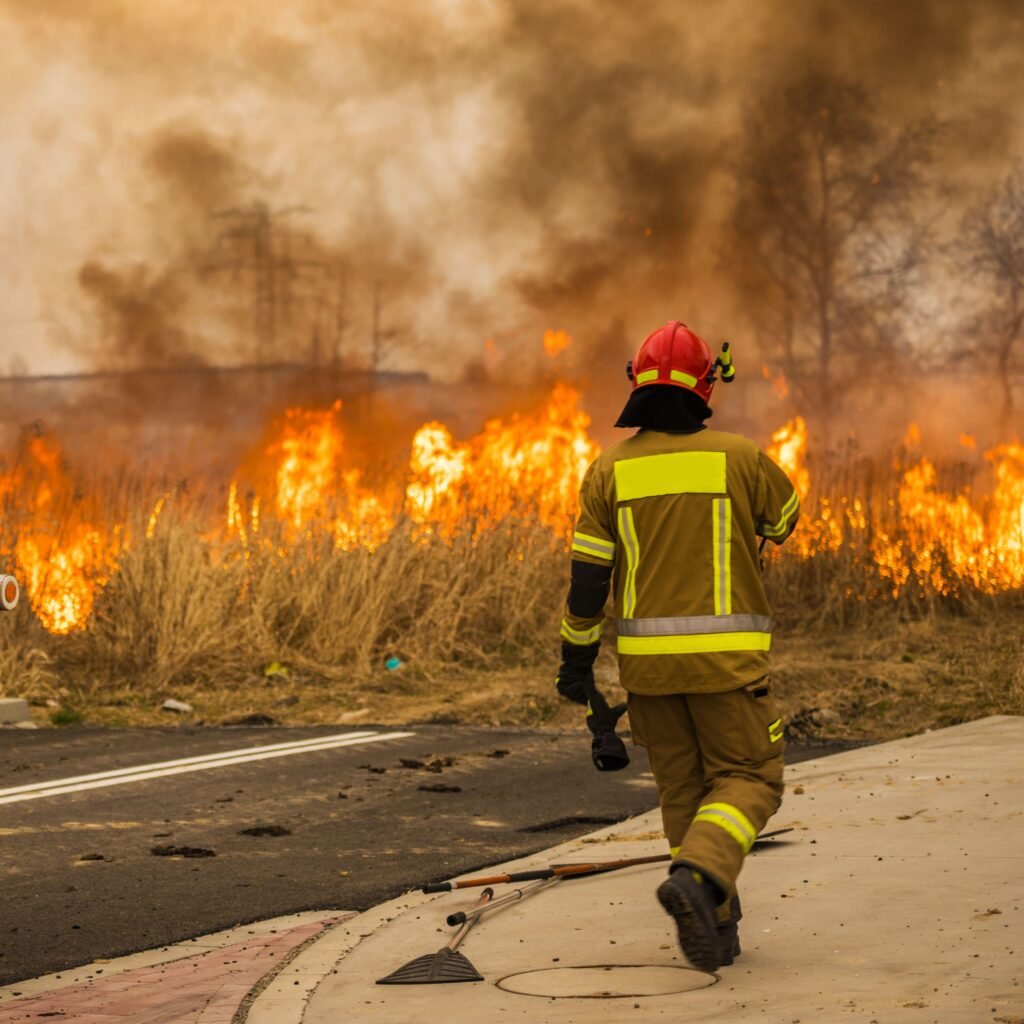Last Updated on July 11, 2025
I witnessed some crazy wildfires back when I lived in California. The Atlas and Patrick fires both burned less than 15 miles from my home in 2017.
As someone who’s lost everything to fire before, it was an incredibly uneasy and tense time. And it only seems to be getting worse – the Canadian wildfires were so bad in 2023 that the smoke reached New York.

Wildfires aren’t always linked to climate change – sometimes they’re started by arsonists, mismanagement, or natural causes. But climate change is definitely making wildfires worse and more frequent – leading to something called fire weather.
But what exactly is fire weather, and how can we prepare for it? Is there a way to prevent it? Here’s everything you need to know to keep yourself informed, safe, and ready.
what is the definition of fire weather?
Fire weather refers to any time the conditions are right for a blaze – typically issued as a warning when an area has been too hot, dry, and windy for substantial amounts of time. Fire weather doesn’t mean there are any actual fires – it simply means there could be.
According to NOAA, fire weather watch alerts will be issued whenever these three critical elements are met:
- sustained winds averaging 15 mph or greater
- relative humidity 25 percent or less
- temperature 75°F or greater
When these fire weather conditions are met, the landscape is primed for really disastrous infernos that can be difficult to control and put out.
For instance, The Camp Fire of 2018 moved so quick that it overwhelmed the city of Paradise, killing 86 people, many trying to leave in their cars.

what are the 5 critical fire weather conditions?
The five critical fire weather conditions include high air temperatures, low precipitation, low soil moisture, low relative humidity, and gusty winds. When you mix all five of these together, you get ample weather that fuels fires.
Here’s a deeper dive into each element:
- High air temps: Very warm temperatures can strip moisture from easily combustible materials, like grass
- Low precipitation: Lack of rain or snow, or in extreme cases, a drought
- Low soil moisture: When soil moisture is low, vegetation is likely dry and stressed, making it easy kindling
- Low relative humidity: If there’s a lack of water vapor in the air, it makes kindling (grass, brush, etc) easier to burn
- Gusty winds: Winds can strengthen flames, should a fire ignite
how do you prepare for fire weather?
The best way to prepare for fire weather is to stay on top of weather conditions. Springtime is when most wildfires occur, but secondary fire weather season occurs during fall.
Be mindful that climate change affects wildfires, making them more common and less predictable. Be sure to monitor alerts on your phone and check National Weather Service (NWS)’s fire weather map consistently.
Another way to prepare for fire weather is to create an action plan, in case there is a fire. You should research and check your location on FEMA’s website to get information about disaster declarations in both the past and present.
Listen for wildfire evacuation orders and take them seriously: Devise a plan with your family members so you all know where to regroup and meet, should you have to evacuate.
Having a bug out bag full of supplies is a great idea. A bug out bag can be stashed under the bed, in a closet, or in a car – but it should be somewhere you can easily access.
Here’s what to pack in a bug out bag:
- First aid kits
- Medications + supplements
- Physical maps (important if you lose GPS signal)
- Essential documents (passport, insurance, birth certificate, etc.)
- Flashlights
- Pet food + supplies
- Non-perishable food (canned goods, trail mix, etc.)
- Water (4-pack of aluminum bottled water)
- Extra phone chargers (Nimble is a sustainable brand that uses recycled materials)
- Solar powered radio
- Extra clothing and pairs of underwear (ideally enough for a week)
- Toiletries (safety razors, shampoo bars, body wash, etc.)
- Menstrual care products (Kayaness and/or organic tampons)
RELATED: How to Build An Eco-friendly Emergency Kit

how can we reduce chance of wildfires?
Obviously being prepared for the worst is important, but what if we could reduce their occurrence? Good news:There are several ways we can reduce the likelihood of fire weather alerts (and wildfires in general).
controlled burns
It may seem counterproductive, but doing controlled burns will help reduce wildfires. Why? Because a planned fire can remove dead grass, fallen tree branches, dead trees, and thick undergrowth – aka, the kindling that fuels wildfires.
Planned burns are done when weather conditions are not fire weather conditions – and can be properly controlled and monitored. Ash from burnt vegetation also releases nutrients back into the soil, allowing for new vegetation to grow and promoting biodiversity.
You can learn more about controlled burns via Nat Geo but it’s important to note it’s nothing new – indigenous people have been practicing controlled burns for decades. We can advocate for more controlled burns by writing to our local reps, learning more about them, and simply spreading awareness.
tackling climate change
By having strong climate policy in place, we can ensure fire weather becomes less common. Voting for people who vow to protect the environment – both on local and national levels – is essential to this.
Getting involved in your government, emailing and calling your local reps, and volunteering your time at environmental non-profits are all great ways to fight climate change on a collective level.
On an individual level, taking steps to reduce your own carbon footprint too (like switching to renewable energy and driving less) is also a great idea. And of course, don’t forget to make plastic-free swaps or start composting if you haven’t yet!
RELATED: 4 Ways to Fight Climate Change as One Person
creating drought tolerant lawns
If you live in a state that’s prone to droughts (like California), investing in drought-tolerant landscaping is a great way to reduce risk of fires. Drought-tolerant plants require less water and can be less susceptible to igniting.
Xeriscaping is worth looking into, as well as planting fire-resistant plants (agave, succulents, red yucca, etc).
Looking into native plants is also worth checking out, as these plants require less maintenance and tend to be more durable in your specific climate. My friend Shelbi recently turned her lawn into a native pollinator habitat and I’m here for it!
Do you have any questions on fire weather? Let me know in the comments!
The post What Is Fire Weather? Is it Preventable? appeared first on Going Zero Waste.














